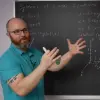

NARROW DISPLAY WARNING
You are most likely using a tablet or mobile device in portrait orientation. This website is best viewed using a typical computer screen with the browser window maximized.
Viewing this website in portrait orientation can cause problems with equations being longer than the screen width (you can scroll to the right), images being poorly sized, and the font size of maths text being much smaller than regular text. If your only option is a tablet or mobile device, your viewing experience will be better if you view this website in landscape orientation. You might need to refresh the page to fix any problems after rotating.
The solution to an initial value problem $y'=f(x,y)$, $y(x_{0})=y_{0}$ doesn't always exist for all values of the independent variable $x$, and sometimes the dependent variable $y$. Two causes are vertical asymptotes and infinite slope. The interval of validity is the region that a unique solution to the IVP exists. The region will contain the initial condition $(x_{0},y_{0})$ and there can be different intervals of validity based on the initial condition.
The interval of validity for a linear first order ODE can be determined without solving the ODE. For a nonlinear first order ODE, the best way to determine the interval of validity is to solve the ODE and determine the interval of validity from the solution. The Existence and Uniqueness Theorems have conditions for when a solution exists and is unique, but provides no information on how far way from $(x_{0},y_{0})$ a solution will continue to exist, i.e. the interval of validity.
For the initial value problem,
\begin{equation} y' + p(x)y = g(x) \qquad y(x_{0}) = y_{0} \end{equation}The interval of validity, meaning a unique solution to the IVP exists, is the interval containing $x_{0}$ with the left and right endpoints the first discontinuities of $p(x)$ and $g(x)$ to the left and right of $x_{0}$. If there is no discontinuity to the left or right of $x_{0}$, then the interval of validity extends to $-\infty$ or $+\infty$, respectively.
Find each interval of validity for the IVP depending on $x_{0}$.
\begin{equation} y' - y = 0 \qquad y(x_{0}) = y_{0} \end{equation}Find each interval of validity for the IVP depending on $x_{0}$.
\begin{equation} y' + \frac{1}{x}y = 0 \qquad y(x_{0}) = y_{0} \end{equation}Find each interval of validity for the IVP depending on $x_{0}$.
\begin{equation} (x^{2}-25)y'+y=0 \qquad y(x_{0}) = y_{0} \end{equation}For the initial value problem,
\begin{equation} y' = f(x,y) \qquad y(x_{0}) = y_{0} \end{equation}The best way to determine the interval of validity is to solve the IVP and determine the region where that solution is continuous. For a nonlinear ODE, the value of $y_{0}$, as well as $x_{0}$, can affect the interval of validity.
Solve the initial value problem and determine the interval of validity.
\begin{equation} y' = \sin(y) \qquad y(x_{0}) = y_{0} \end{equation}Solve the initial value problem and determine the interval of validity.
\begin{equation} y' = 3(3-y) \qquad y(x_{0}) = y_{0} \end{equation}